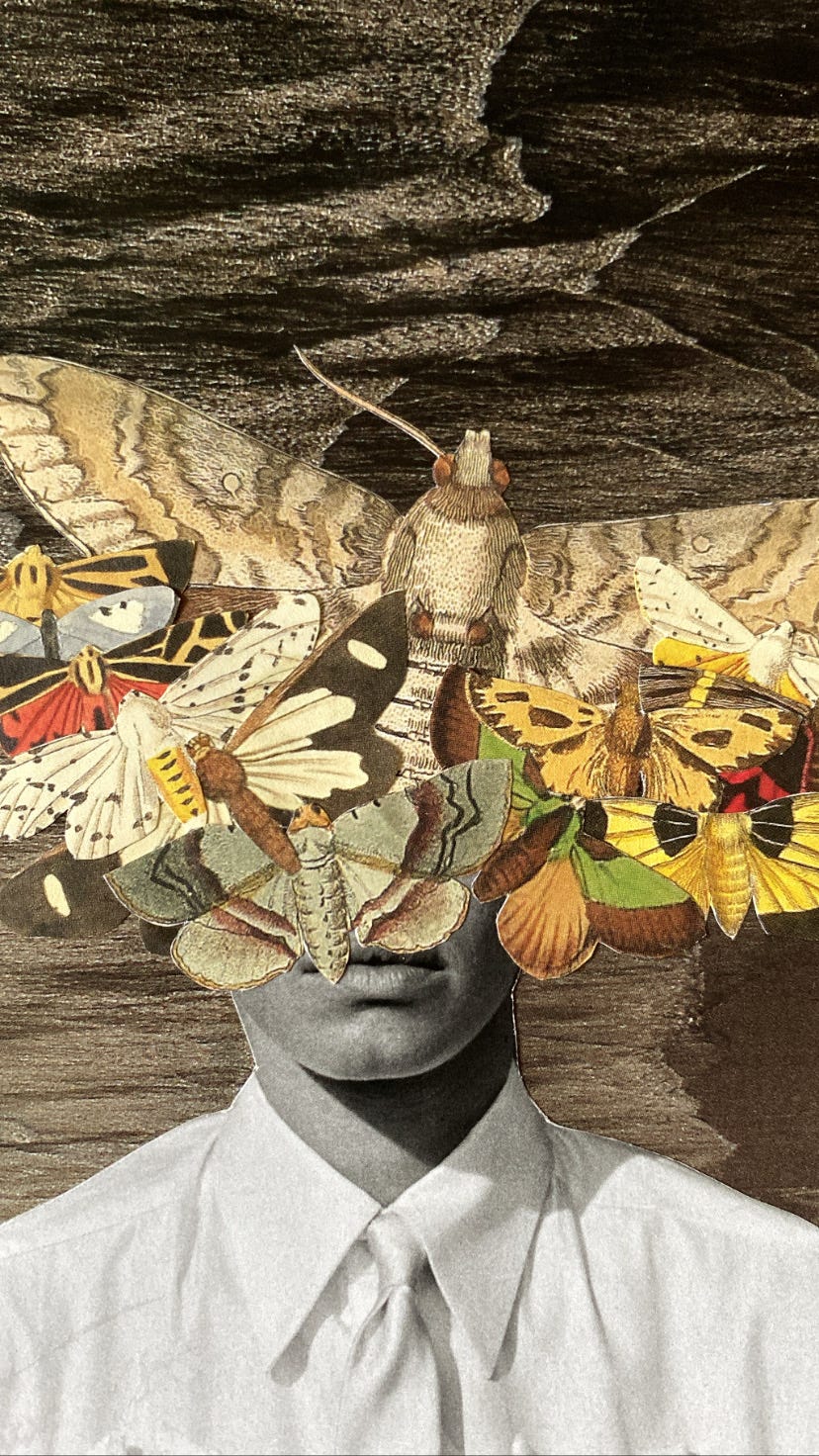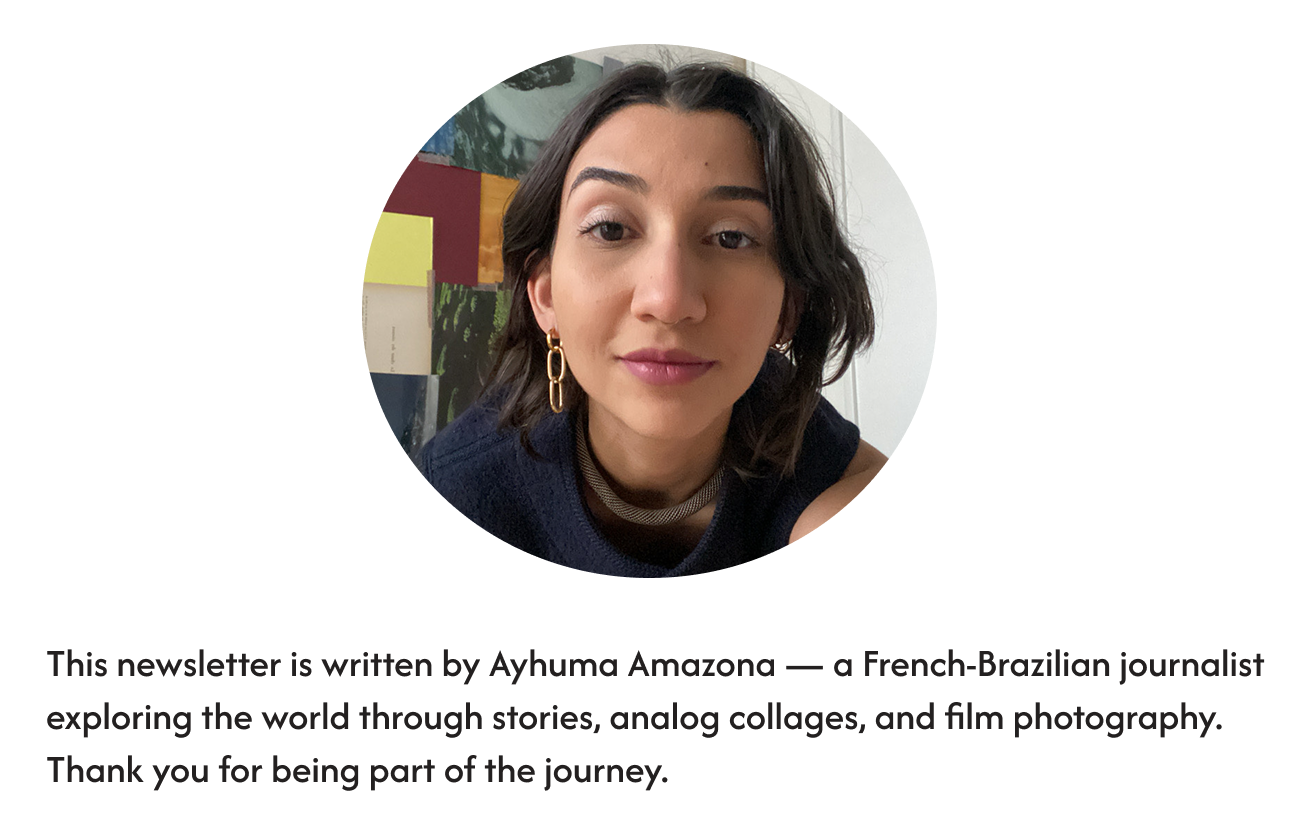13| What My Creative Block Taught Me About Life,Art,and Myself
From fear and pressure to intention and joy, here are 9 lessons that helped me reclaim my creative flow.
analog collage made by @ayhumaamazona
As I walk down memory lane to write today's newsletter, I realize how much I learned —about art, creativity, and what I am capable of—during my 4 years of creative block.
Feeling stuck and trapped was mentally exhausting, and it pushed me into a vulnerable place.
Yet, amid all the chaos and self-doubt, this experience taught me to approach life and creativity with intention.
It took me quite some time to understand that being intentional is the key to freeing ourselves to live the life we want — without being constantly tossed around by life’s random events.
When you know where you’re headed and why, you create space for your who to evolve as needed, because you realize there are countless ways to get from point A to point B.
The real question is: are you truly committed to your journey?
9 Insights I gained from my creative block:
1. Creative blocks aren’t just about lack of inspiration
I found it frustrating that most of the literature about creative blocks treats lack of inspiration as the main cause. Well, for me it is just a symptom.
Creative blocks often come from deeper fears: fear of connecting with others, fear of the unknown, fear of not being good enough, or fear that people will find your art too strange.
There’s also a paradoxical fear I’ve felt myself, the fear of succeeding at something you love.
2. Creativity requires commitment
Creativity is like a plant. You can’t water it once a year and expect it to flourish. Commitment means consciously nurturing your creativity.
How much time, energy, and resources you dedicate is up to you. But know that the results will reflect your investment.
3. You don’t need to be a full-time artist to live creatively
Growing up, we’re taught that creativity is something natural only for children and artists, which is a huge misunderstanding of what creativity really means.
It ignores that creativity takes many forms and manifests differently from person to person.
Everyone is creative. And even if you don’t work as an artist, it is scientifically proven that your mental and physical health benefits from doing manual crafts and exposing yourself to beauty and the vulnerability of the creative process.
4. The world needs your unfiltered artistic voice
Fear and comparison hold many of us back from chasing our dreams and expressing our true selves.
For too long, art has been framed from an elitist perspective, making us put others’ work on a pedestal while doubting our own.
But that doesn’t have to be the case. Creativity blossoms when we give ourselves the freedom to be authentic, and that’s a power we all hold.
5. Know your reasons and your why
Whether you’re blocked or not, it is important to have clarity about why you create.
To have a healthy relationship with creativity, your reasons must be about you and what truly speaks to your soul.
When you start creating for others, you lose yourself.
6. Set the stage for creativity
Create an environment that inspires you and supports your creative work. Pay attention to the small rituals that help you get into a good flow— like lighting a candle, or playing some music.
Also, try choosing a specific day and time each week to work on a creative project.
Committing to this routine makes it easier to show up for yourself and your process, instead of constantly postponing it.
7. Make space for stillness
This was one of the hardest lessons for me to accept, because it felt so contradictory.
But over time, I learned that creativity needs space to breathe.
Sometimes, the most powerful ideas come when we’re doing nothing—when we allow ourselves to daydream, rest, or think about something completely unrelated.
Taking intentional pauses isn’t laziness—it’s part of the process.
8. Don’t underestimate the power of decluttering
A tidy home means a tidy mind. If you’re feeling stuck and confused, clutter will only worsen the fog.
Clear your space, your desk and your home, and watch how much clearer your thoughts become.
9. Give yourself permission to enjoy making “bad art”
In a world of constant stimulation and social media, it’s easy to feel like you have to create — and share — something new every single day.
But that pressure isn’t sustainable, and it doesn’t suit every kind of art or creative rhythm.
So take the pressure off, and stop being afraid of making something you don’t like, or something you think is ugly.
You don’t need to create every day, and not everything you make has to be a masterpiece.
Find joy in simply playing with ideas, exploring what comes up. Sometimes you’ll make something you love—and sometimes you won’t.
But even the “bad” work teaches you something and brings you closer to the art you’re proud of.
On my journey, three books in particular helped me navigate my creative block and reconnect with my process.
Each one brought a unique perspective, and together they truly complemented each other. I sincerely recommend:
The Creative Habit: Learn It and Use It for Life by Twyla Tharp
The Artist's Way: A Spiritual Path to Higher Creativity by Julia Cameron
The Artisan Soul: Crafting Your Life into a Work of Art by Erwin Raphael McManus
Art and creativity are recurring themes in my reflections, and I’m always looking for new inspiration.
Do you have a book to recommend on the topic? I’d love to hear what’s resonated with you lately.



